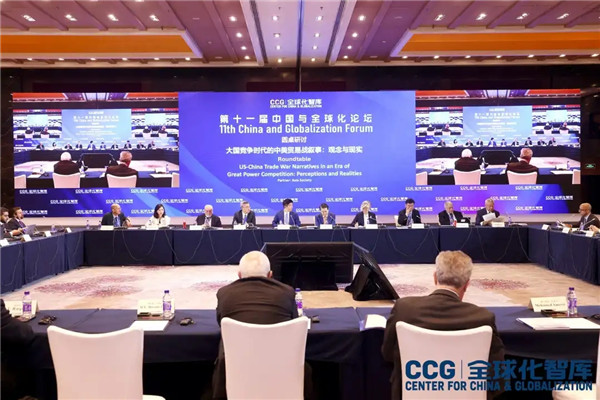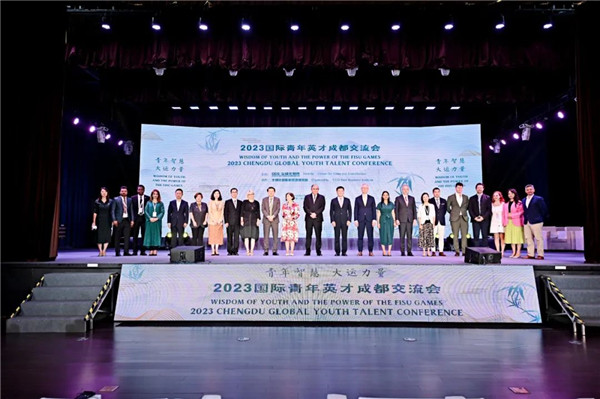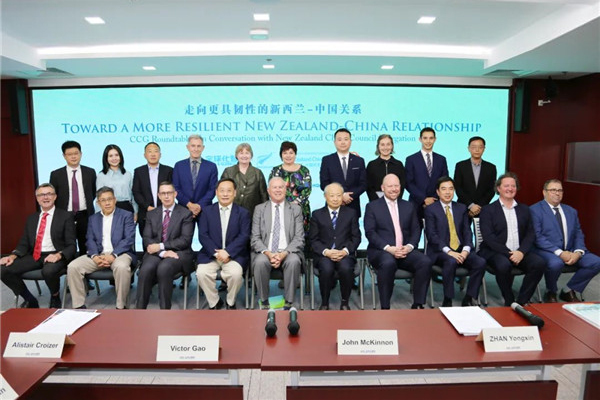CCG and BRIJC Roundtable: Future of Sino-Japanese relations and 40th anniversary of the bilateral peace treaty

On September 14, the Center for China & Globalization (CCG) and the Belt and Road Initiative Japan Research Center (BRIJC) held a joint seminar to mark the 40th anniversary of the signing of China-Japan Treaty of Peace and Friendship and to explore cooperation between the two countries.
Recently, the Japanese government and Prime Minister Shinzo Abe of Japan have repeatedly expressed positive views on relations with China. In September, President Xi Jinping met Prime Minister Abe during the Eastern Economic Forum in Russia. Premier Li Keqiang also met with a Japanese economic delegation including more than 200 executives from major Japanese companies. This has shown the relationship between China and Japan is improving. Accordingly, Chinese and Japanese experts and scholars and representatives of the Japanese business community conducted an in-depth discussion on several topics such as the development of bilateral relations, cooperation under the Belt and Road Initiative, and regional cooperation.
BRIJC was established on the occasion of the 45th anniversary of the normalization of diplomatic relations between China and Japan in 2017. It is the first think tank dedicated to the Belt and Road Initiative research in Japan. Former Prime Minister of Japan Yasuo Fukuda is the supreme adviser of BRIJC and over 50 expert consultants from the Ministry of Foreign Affairs of Japan, the Ministry of Economy, Trade and Industry officials, scholars and media work for the center.
The Japanese delegation for this seminar included the leader Eiichi Shindo (President of BRIJC, Emeritus professor of Tsukuba University); deputy head of the delegation Professor Zhou Weisheng from Ritsumeikan University; and more than 10 scholars from various universities and research institutions in Japan.
Chinese participants included CCG President Wang Huiyao; Su Hao, CCG non-resident fellow and director of the Center for Strategic and Peace Studies of the School of Foreign Affairs; Ping Zeshun, head representative of Marubeni Corporation in China; Miao Lu, CCG vice president and secretary general; Xu Haiyu, CCG Deputy Secretary-General, Qin Gang, executive director of CCG China Institute for the Globalization of Cities; and Nie Ligao, CCG director of international communication Nie Ligao. Domestic and foreign reporters also attended the seminar.

CCG President Wang Huiyao gave opening remarks. He pointed out that the seminar provided a good opportunity to review the 40th anniversary of the “Sino-Japanese Treaty of Peace and Friendship,” which also coincided with the 40th anniversary of China’s reform and opening up. Over the past 40 years, Japan has helped China in different ways. For example, Japan’s Official Development Assistance (ODA) has benefitted many regions in China and the two sides have achieved remarkable progress with cooperation in many areas.
In the future, Wang voiced hopes that China and Japan will keep cooperating on several issues, such as the Belt and Road Initiative, TPP, RCEP, and relevant technical standards. He hoped that the seminar could facilitate constructive discussion on the development of Sino-Japanese relations and cooperation.

Following this, BRIJC President Eiichi Shindo noted how Sino-Japanese relations have experienced twists and turns since China overtook Japan as the world’s second-largest economy in 2010. This milestone had a big impact on many Japanese. However, Shindo also emphasized that from a long-term perspective, China was more advanced than Japan for more than 2,000 years. Japan, which is at the eastern end of the Silk Road, was greatly influenced by China and its civilization. In the 19th and 20th century, the UK and US dominated globalization. Shindo said that In the 21st century, China and Japan should work together to promote a more humane form of globalization. This also is the responsibility of CCG and BRIJC.
Following these opening remarks, experts shared perspectives on Sino-Japan relations.

Zhou Yusheng believes that the ultimate goal of the Belt and Road Initiative (BRI) is to promote the sustainable development of the world. Therefore, China and Japan should cooperate in building low-carbon, sustainable communities in countries participating in the BRI.
During Premier Li Keqiang’s visit to Japan in May 2018, China and Japan signed the Memorandum on China-Japan Cooperation in Third-Party Markets, laying the foundation for cooperation between China and Japan under the BRI. In addition, Zhou suggested that creating a United Nations University for South-South Cooperation in China would help countries to learn from each other.

Turning to international development cooperation, Takeuchi Yukifumi, editorial board member of the International Development Journal, pointed out that China’s overseas investment decisions were made in a shorter time and on a larger scale than Japan’s. This has contributed to misunderstanding and the so-called “China threat theory.”
Moreover, Yukifumi said that Japan’s overseas investment decision makers care about the influence of these decisions on the environment and local communities and said that China will make improvements on these aspects after the establishment of the National International Development Cooperation Agency. He also suggests that Japan can provide useful advice to China on international development and suggested that China should propose a clear economic model or a Chinese-style development model that can attract the Japanese to work with China.

Shi Guyou, representative of the 21st Century Silk Road Research Institute of Japan in China, expressed his views on offshore energy transportation. He said that the transportation of inputs such as coal, oil, natural gas and electricity need to be coordinated as they are all intimately linked to industry, people’s daily lives, and the military.
In July this year, Yamal LNG from the Arctic was transported to China through the Arctic Ocean. This was considered a major landmark in energy transportation cooperation, with Russia and France at the core of the project. Japanese companies have also played an important role in transportation and financing. In the past, land and sea transportation was clearly differentiated, but now it is increasingly difficult to separate the two. This means that the BRI is not only an east-west interaction, but also a potential north-south interaction through Arctic shipping routes.

Li Ruixue, professor at Hosei University in Japan, introduced his research on railways and logistics clusters in Central Europe. He said that the emergence of shipping containers has changed the entire world trade pattern and development model.
Li said that creating an international logistics cluster along railways in Central Europe would spur the growth of new development models. He also pointed out that this kind of strategy could make inland cities more “coastal,” enjoying advantages in logistics, port facilities, and international transport. It would also help to reshape the configuration of international supply chains.

Zhu Yan, a professor at Takushoku University, observed that many Japanese companies are interested in the BRI but reluctant to work with Chinese partners due to bilateral tensions in recent years. Therefore, most Japanese companies are still collecting information on the BRI.
Zhu suggested several ways for China and Japan to work together under the BRI: First, Japan can participate in Chinese enterprise projects. Second, China can participate in Japanese enterprise projects. Third, Japan can learn from China’s experience in infrastructure development. Fourth, Japan can provide advice based on its successful development experiences. Fifth, Japan can join the BRI industrial cluster. In addition to political factors, for successful long-term cooperation, it is important that companies from both countries respect and learn from each other.

Based on personal experience and firm practices, the head China representative of Marubeni Corporation, Ping Zeshun, gave an overview of growing cooperation between Chinese and Japanese companies since the China-Japan Treaty of Peace and Friendship was signed.
Ping said that in the first 20 years of cooperation, many business opportunities arose because China needed Japanese financial and technological support, while Japan needed China’s cheap labor. In the following 10 years, China needed more advanced technology, and Japan needed China’s huge market. This trend has not changed significantly over the last ten years, although China overtook Japan in some areas such as IT and financial technology, something that Japanese firms can learn from.
Ping says that Japanese companies should strengthen cooperation with Chinese companies. Marubeni Corporation has already cooperated with Chinese companies and worked closely with countries along the Belt and Road, such as Vietnam, Kazakhstan and Angola. It has gained rich experience in cooperation in third countries between China and Japan.

On the topic of East Asian regional cooperation, Ijuin Atsushi, the principal researcher of the Japan Center for Economic Research, pointed out that a security and peace mechanism is vital for Northeast Asia. In the longer-term perspective, he also stressed the need for closer economic cooperation into account. If economic sanctions can be lifted following the denuclearization of North Korea, countries in the region will need to consider how to build a new economic order in Northeast Asia.
At present, relevant countries in Northeast Asia have proposed many new policies, such as China’s Belt and Road Initiative, Russia’s “New East Asia Policy,” and South Korea’s “New North” Policy. Northeast Asian countries need to work together and prevent conflicts that could arise due to North Korea. Atsushi highlighted the need for platforms to facilitate regional dialogue, such as the Economy and Energy Working Group from the earlier Six-Party talks.

Su Hao, CCG senior fellow and director of the Center for Strategic and Peace Studies at the Foreign Affairs University, argued that it is time to deepen cooperation between China and Japan.
Su said that East Asia’s economic development is transitioning from a “flying geese model” to a “horizontal axis model,” with cooperation between countries is changing from step-by-step cooperation to multi-level, multi-field collaboration model in which many countries benefit from participating in China’s industrial chain.
Su noted that China and Japan have more incentive to cooperate. The “2+1” model of cooperation between China and Japan in Southeast Asia and other places should be further recommended to the government and policymakers. Furthermore, in future, China, Japan and North Korea can adopt a “3+X” cooperation model overseas to facilitate more efficient industrial division, forming industrial clusters, and leveraging complementary advantages.
Experts have also shared their views on Sino-Japanese cooperation from a broader perspective of policy, culture and philosophy. Miao Lu, CCG vice president and secretary general, believed that China should learn from Japan’s experience in handling foreign investment, an aging society, and management of international talent.

Miao also pointed out that many Chinese companies would like to invest in chemical, manufacturing and other industries in Japan but face challenges in doing so. She pointed out the value of harmonious bilateral relations to both China and Japan and hoped both sides could contribute Confucian culture to promote globalization. Miao also expressed hope that CCG would have more opportunities to interact with Japanese think tanks and enterprises.

Senshu University Professor Hiroo Harada also expressed his views on social capital and interpersonal relationships. According to research, Harada sees no inevitable connection between human satisfaction, feelings of happiness and economic development. He noted that many Japanese see the BRI as a purely economic and industrial initiative, and argued that non-economic indicators should be emphasized to appeal to countries such as the US that value a broad concept of human development. To enable this, Harada called to establish long-term mechanisms and permanent institutions, such as an OECD-like institution.

The seminar saw wide-ranging, in-depth discussions from a range of Chinese and Japanese experts. In the future, CCG will work to continue exchanging ideas with Japanese think tanks and companies including BRIJC, and make efforts for the continued development of Sino-Japanese relations.






